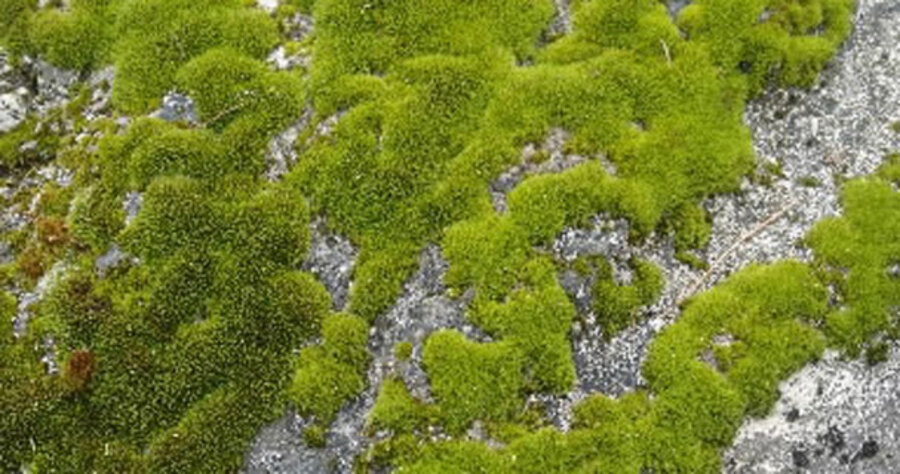Grow moss -- on purpose?
Moss is the “first responder” of the plant world. Along with lichen, it moves in to stabilize areas destroyed by fire or other disasters. It comes equipped with shallow roots that trap water and particles, staving off erosion. In home gardens, however, its eagerness to colonize can frustrate gardeners.
William Cullina favors moss in the garden. So much so that he includes it in his latest book, “Native Ferns, Moss & Grasses.” It’s third in a series on native plants, following his first guide on growing wildflowers and his second, on trees, shrubs, and vines. Mr. Cullina (pronounced kul-EYE-nuh) directs the horticultural research program for the New England Wild Flower Society in Framingham, Mass.
While many gardeners appreciate the beauty and utility of ferns, and still others are discovering the versatility of grasses, people tend to be less enthusiastic about moss. Cullina understands this reluctance to embrace moss in the garden. It’s one thing to encounter it covering a fallen log on a hike through woodlands. It’s another to find the plant insinuating itself into lawns and flower beds.
Each year, homeowners resort to treatments to discourage moss. Cullina says unless the conditions are changed that moss favors – shade, compacted soils, and high levels of moisture – trying to get rid of it is a waste of time. It will just grow back. “You’ll find moss under any turf grass. It’s a symptom, not a cause,” he says.
Just as suburban gardeners have been rethinking large sweeps of lawn, people may need to rethink plants that have been largely ignored. Cullina wants to get people excited about moss and thinking about how to use it to best advantage. “Moss gives a patina to the garden, a sense of age,” he says.
Moss also offers “a subtle variety of texture and color, a visual sophistication,” Cullina says. He points to Japanese gardens, where the play of texture is more important than bright flowers: “The serenity and simplicity of green on green allows you to notice detail.” Color can be overdone; too much is distracting.
Designers recognize the tranquil qualities imparted by moss. In New York, the atrium garden enclosed within the New York Times Tower, which opened in November, features an elegantly simple arrangement of seven paper birch trees and 6,000 square feet of native moss. Canadian landscape architect Cornelia Hahn Oberlander chose common haircap moss and fern moss to create lush cushions of emerald green.
Thousands of different kinds of moss can be found from coast to coast; Cullina’s book features 13, including some common ones that are easily cultivated. Seen close up, several of the moss varieties have definite fronds, much like tiny ferns, that come together in nature’s shag carpet. Others, such as broom moss, form the familiar velvety mounds between rocks. Moss can be grown on garden containers and stone outcroppings and walls, as well as in between bricks or patio pavers. On a recent guest appearance on Martha Stewart’s television show, Cullina demonstrated how to make a moss “smoothie” in a kitchen blender – a liquid concoction of ground-up moss and liquid to spread on rocks and other surfaces where you’d like moss to grow.
Cullina, who lives in Woodstock, Conn., prefers to grow moss on rocks and fallen logs on his property. He digs up small patches of moss from one area and transfers them to another site with similar conditions, keeping the patches well watered until they “take.” He discourages people from collecting moss in the wild because that can lead to habitat destruction.
He also raises questions about whether the dried moss sold in craft and floral supply stores is harvested using sustainable methods. “It’s the scale of commercial production that concerns me,” he says. “The analogy is clear-cutting [forests] versus selective harvesting. With selective harvesting, plants grow back faster.” But with bagged moss, there’s no way to know how it was collected.
Sphagnum moss (often referred to as peat moss) is mined extensively from peat bogs and used by countless gardeners to improve the soil. Concerns persist about its sustainability. While the Canadian Sphagnum Peat Moss Association, for instance, says that the harvesting is done sustainably, Cullina supports using alternatives such as ground coconut fiber (coir).
Moss in the garden offers advantages and disadvantages. To maintain a pristine look, gardeners need to rake off debris or use a leaf blower, taking care not to break off the delicate mats of shallow root. Moss remains evergreen if it has sufficient moisture, providing color in winter, but it turns yellow or brown when dried out. Many gardeners find dried moss an annoyance because it’s easily scuffed up underfoot and prefer to rake it out. However, squirrels and birds line their nests with dried moss.
Another less-heralded role involves sensitivity to pollution, according to Cullina. Both moss and lichen are affected by pollutants and road salts. They could be viewed as indicator species – like frogs – that are the first to feel the effects of habitat degradation. “As you get closer to cities, the number of moss varieties goes down,” he says. Still, some mosses survive even in tough urban settings. For example, silvery sidewalk moss draws sustenance from runoff fertilizers and proximity to concrete.
Moss will become more of a featured performer in the garden, rather than a bit player, as gardeners come to appreciate its durability and beauty.





